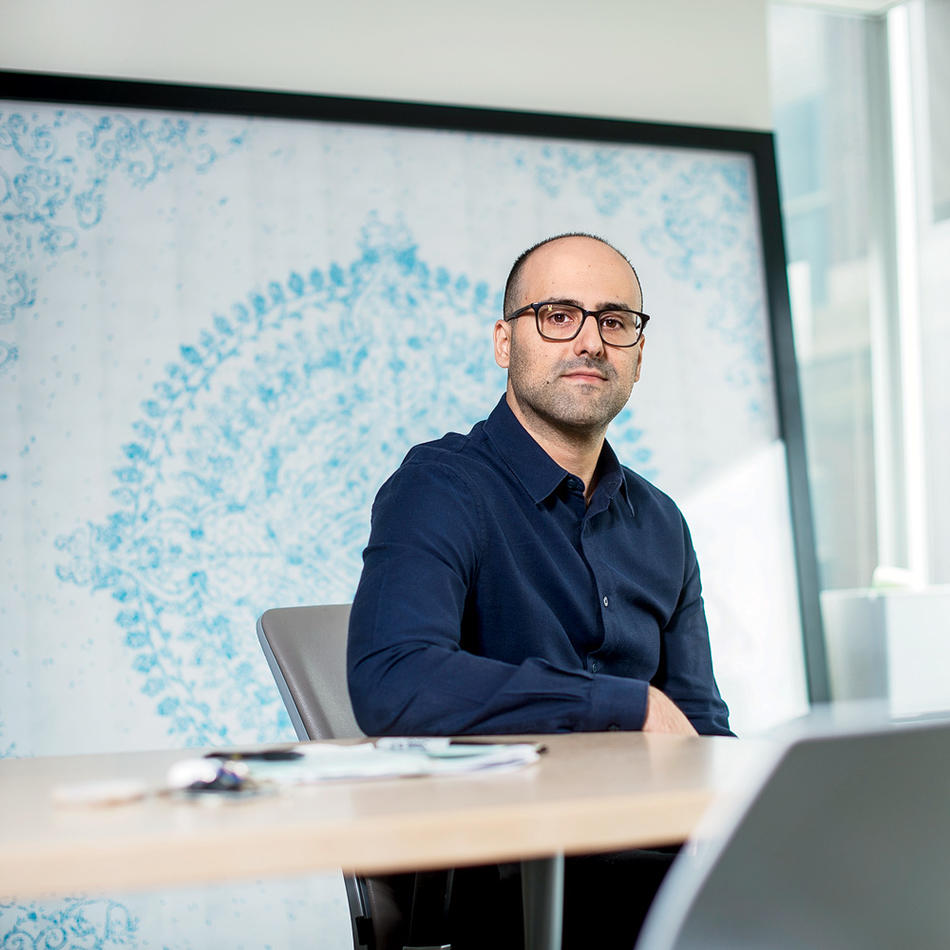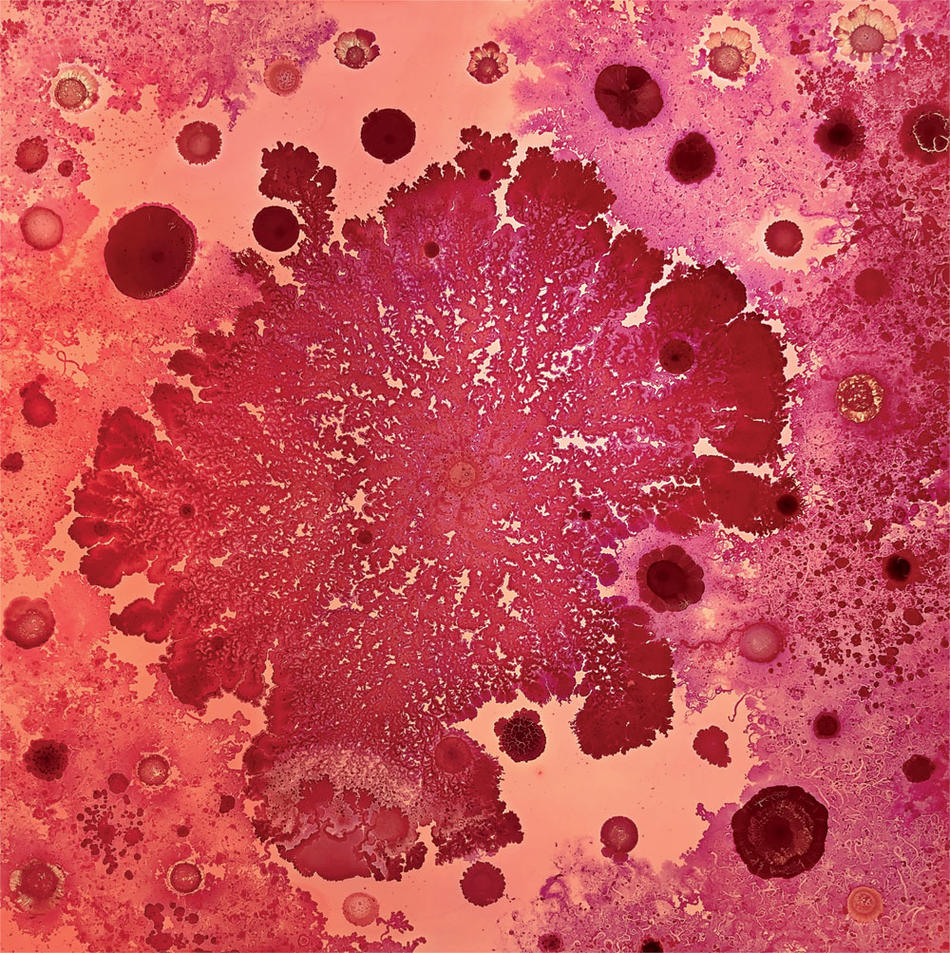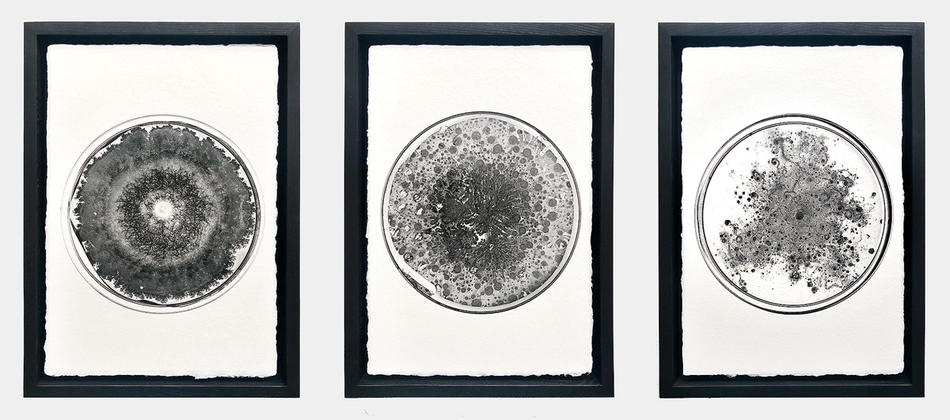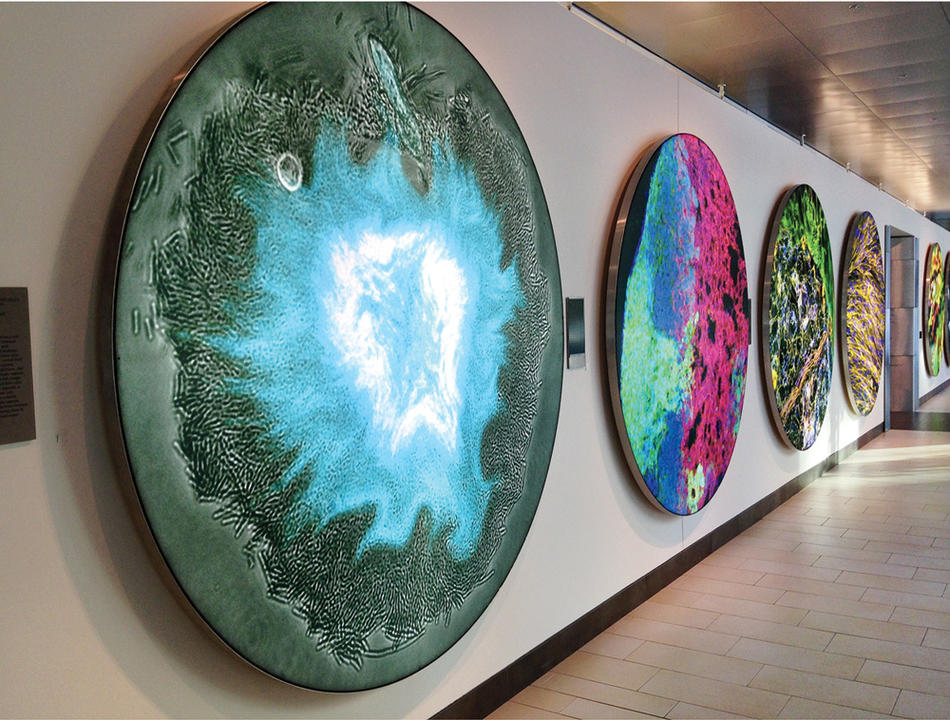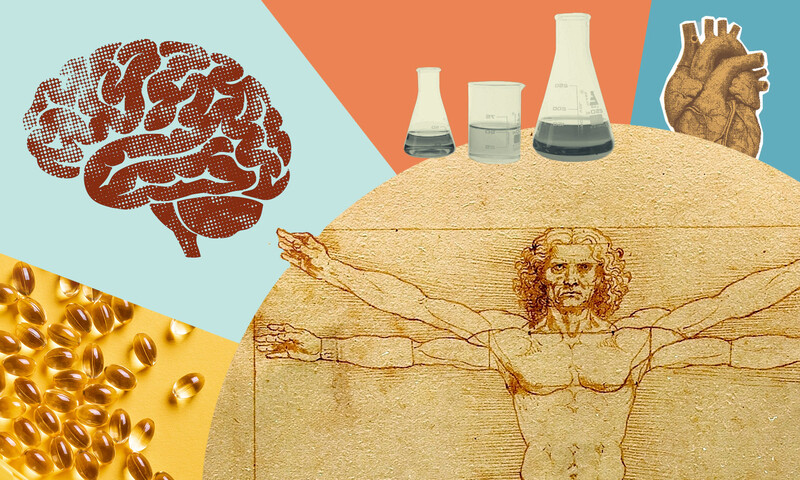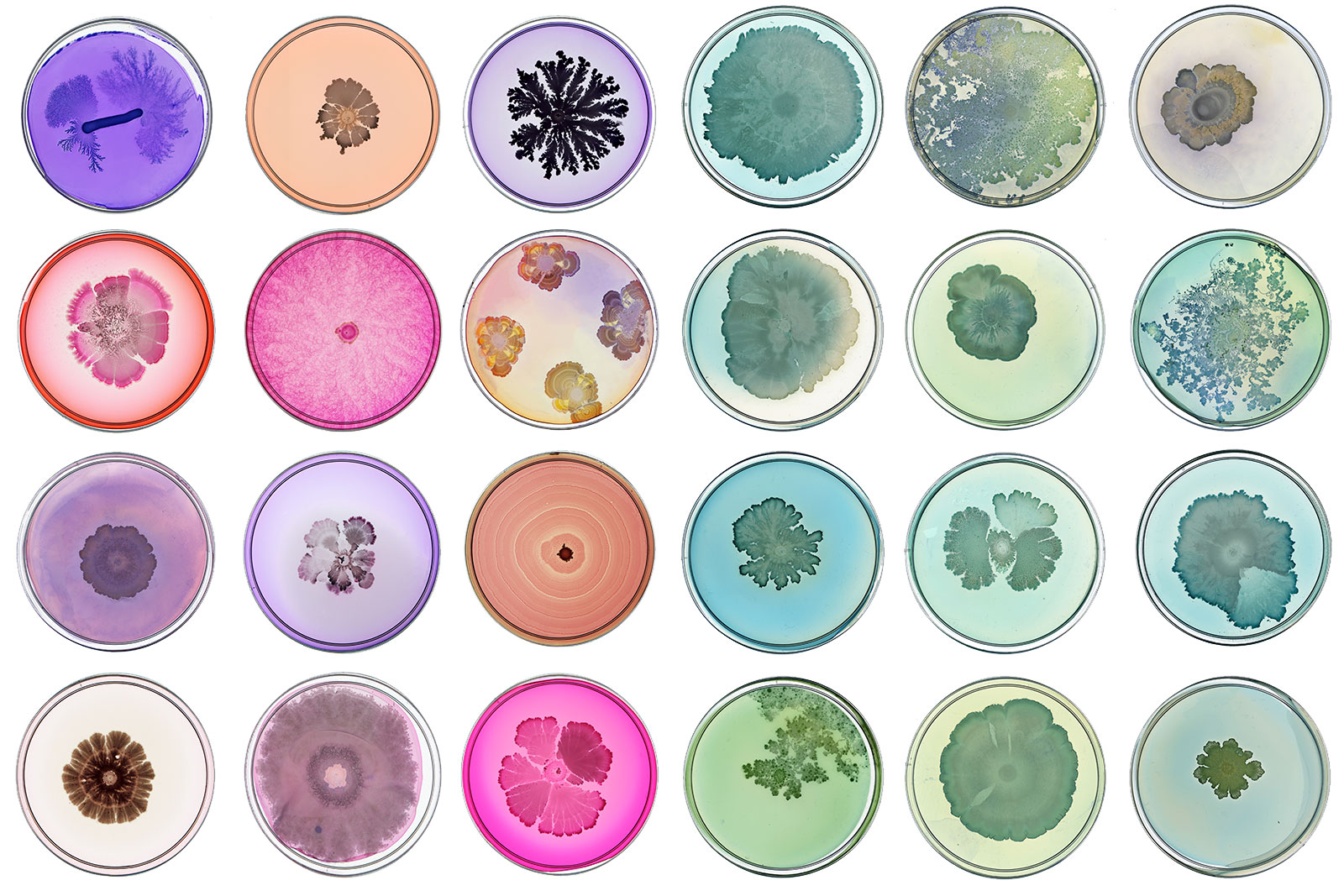
John James Audubon drew birds, Georgia O’Keeffe ’71HON painted skulls, Damien Hirst pinned butterflies to canvas. But Tal Danino’s art cuts even closer to nature’s core: his palette is alive, his paint made of the oldest, smallest, most abundant creatures on earth.
In a laboratory in the Northwest Corner Building, Danino, an assistant professor of biomedical engineering, is growing bacteria. Danino works on the frontiers of synthetic biology, a young discipline in which biological systems are genetically redesigned to perform useful tasks. Combining the remarkable abilities of bacteria and the power of genetic engineering, Danino is targeting cancer — specifically, he is programming microbes to release medicine inside tumors. But for Danino, bacteria are not just soldiers in a war on illness; they are also singularly beautiful, expressive, and meaningful life forms. As the heroes of his bacterial “paintings,” which have hung in galleries in New York, Beijing, Seoul, and Abu Dhabi, these microbes give new meaning to “still life.”
Danino typically begins his art pieces with a pipette of bacteria and a petri dish coated with agar, a growth medium derived from algae. With the help of researcher Soonhee Moon, he deposits precise droplets, each containing a few thousand bacteria, onto the agar. The bacteria quickly replicate, dividing themselves and spreading out in patterns resembling intense starbursts, delicate blossoms, eyeballs, corals, sprawling continents, and cross sections of agate stone. Using chemical dyes to bring out the intricate motifs formed by the proliferating microbes, Danino takes pointillism to its irreducible limit: images made of millions and millions of microscopic cells.
“I’ve found that the visual component is an extremely powerful way to communicate science,” says Danino. “My overall theme is that the medium — in this case, bacteria — is the message.” That message asks us to consider life and health at the most fundamental level. “We evolved from bacteria,” Danino says. “It’s amazing when you think about it: they are our ancestors, and they also live inside us.”
At Liberty Science Center in Jersey City, Danino’s petri-dish images greet visitors at the Microbes Rule! exhibit. “People seeing the work ask, ‘What is that? What is it made of? What is its significance?’” says Danino. “For me, the art is about provoking questions about what these little things mean and how they connect to our lives.”
Having evolved over billions of years, and having, among other exploits, furnished the planet’s atmosphere with oxygen, these “little things” are a very big deal. Countless and pervasive, bacteria live in forests and deserts, homes and schools, hospitals and restaurants, on the surface of ponds and at the bottom of oceans, in sand and soil, in volcanoes and under ice sheets. Subtle variations in DNA make it impossible to know how many discrete species exist. All told, bacteria are more numerous than the stars in the universe, and in our bodies, where they thrive by the trillions, they perform functions essential to our survival, like making vitamins and coating our guts to prevent illness.
But some microbes can make us sick, a PR problem that has obscured bacteria’s benefits, real and prospective, to human health. Danino, both as an artist and as director of Columbia’s Synthetic Biological Systems Laboratory, is helping to change that. “Though bacteria are single-celled, they are incredibly sophisticated,” he says. “They reproduce asexually, they have tails called flagella that allow them to swim, they mutate to adapt to their environment, and they ‘talk’ to each other through a chemical communication process called ‘quorum sensing,’ in which bacteria reach a certain density and then perform tasks collectively, such as express genes needed for bioluminescence.”
The qualities that make bacteria such dynamic painters — the ability to multiply rapidly and act synchronously — also make them, in Danino’s hands, ideal agents for medicine. This past summer, Danino, with Columbia immunologist Nicholas Arpaia and a co-mentored PhD student, Sreyan Chowdhury, published a paper in Nature Medicine showing that by harnessing the mechanism of quorum sensing, they could program bacteria to shrink tumors in mice.
Their experiments focused on CD47, a protein that is present on the surface of many cells. This protein, a kind of “don’t eat me” signal, tells the immune system that the cell is innocuous, encouraging white blood cells to move along, since no immune-system action is required. As cells age, they lose CD47, allowing the immune system to eliminate failing cells, clearing the way for new ones. But in a cancer cell, CD47 can be erroneously turned on, planting the “don’t eat me” flag and tricking the immune system into ignoring the malignancy.
Danino and his colleagues wanted to find a way to turn off the CD47 signal, while avoiding the side effects of antibody immunotherapy, a form of cancer treatment that rallies the body’s natural defenses. “If you inject the CD47 antibody into the bloodstream, you will see a reduction in red-blood-cell counts or platelet counts,” Danino says. “That’s what causes adverse side effects.” So instead, the team injected genetically reprogrammed bacteria directly into tumors — bacteria built to release, on cue, a payload of CD47 antibodies.
Getting the bacteria to do this required heavy problem-solving. Because bacteria can’t produce complex antibodies, Danino had to direct them to generate simpler antibody-like proteins, called nanobodies, which en masse could stimulate the immune system in the same way. Using DNA customized in his lab, and a non-pathogenic strain of E. coli (which lives in our intestines), Danino devised what he calls a “medicinal Trojan horse.” Once introduced into a tumor, the engineered bacteria begin replicating until they reach a minimal threshold (or quorum) of density. This triggers them to burst and discharge the nanobodies. These nanobodies attach to the CD47 proteins in the tumor, hiding the faulty “don’t eat me” signs and permitting the immune system to identify and consume the bad cells. In the recent experiments on mice, the tumors shrank. Danino is working on translating this technology to humans and hopes to begin trials within three years.
Danino grew up in Los Angeles, the son of Israeli immigrants. His father, who had studied electrical engineering, fostered his love of computers, and his mother, an artist, engaged him with art projects — a favorite involved shaving wax crayons onto paper, folding the paper, ironing it until the shavings melted, and then opening the paper to reveal a dazzling snowflake pattern. This presaged his interest in the elaborate figures made by bacteria and his efforts to mimic and augment these processes in his lab.
“Art inspires a lot of the science that we do,” Danino says. “Artists are really good at exploring. However, when you write a science grant, it has to be as un-crazy-sounding as possible in order to get funded. Art isn’t like that: it’s more subjective and less methodical, more based on intuition and trying crazy ideas. That mindset allows me to jump into the science and develop the story as I go along.”
Danino, who is a member of Columbia's Data Science Institute, undertook his first attempts to program bacteria in grad school at the University of California San Diego, where he merged his interest in computers and math with biology. He became interested in using microbes to improve human health as a postdoc at MIT, and began exploring ways to genetically manipulate bacteria to treat cancer. A few of his collaborative artworks from that era hang in his office. For them, Danino grew cancer cells on a plastic surface, which was then photographed by the Brazilian artist Vik Muniz. One of these photolithographs, HeLa Pattern 1, shows an ornate design made up of the cancer cells of Henrietta Lacks, an African-American woman who died in 1951, and whose unusually hardy cells were harvested without her consent. HeLa cells represent the most commonly used “immortalized” human cell line, meaning that the cells, due to a mutation, keep dividing indefinitely, making them invaluable to science. “Virtually every lab in the world that works on cancer has HeLa cells,” says Danino. “Billions and billions of cells, alive and used today for research.”
The idea of an eternal organism never fails to fire Danino’s imagination. Like Lacks’s cells, bacteria keep multiplying: a single bacterium can become millions within hours. For Danino, the implications, too, are endless.
“A decaying human body causes more life for microorganisms,” he says. “So there’s an interesting connection there between our life cycle and that of bacteria. Our lifespan is finite, but bacteria just keep dividing. They’re immortal, in a way. It’s a different way to think about life.”
And art.
This article appears in the Winter 2019-20 print edition of Columbia Magazine with the title "Microbial Rainbows."
